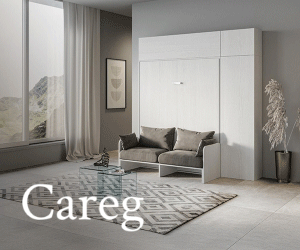by Evi Mibelli.
“You cannot create happiness with beautiful objects, but you can ruin it with ugly ones” – Finn Juhl.
If we want to understand the greatness of Finn Juhl, we just need to look at his house in Ordrup, north of Copenhagen, now home to the museum dedicated to him. Extremely simple in structure, it preserves intact the atmosphere, warmth, balance, and elegance that were characteristic of this master of Danish design. One immerses oneself in his unmistakable aesthetic dimension and remains literally seduced by it. Contemporary of Hans Wegner, Mogen Koch, and Børge Mogensen, he stands out from his illustrious colleagues for a more free-spirited language inclined towards an organic and sculptural vision of design, rather than strictly functionalist, enriched by the use of color.
On the left, Grasshopper Chair, presented in 1938 at the Cabinetmakers’ Guild Exhibition in Copenhagen. Reissued by House of Finn Juhl, exhibited at the Be Your Mirror exhibition, Milan Design Week 2021; on the right, Pelican Chair, 1940. Reissued by House of Finn Juhl.

Finn Juhl was born in Copenhagen on January 30, 1912. He was passionate about studying art from a young age, so much so that he desired to become a historian of art. He frequented the National Museum of Arts and Crafts assiduously and obtained permission to consult the precious books kept in the NY Carsberg Glyptotek Library in Copenhagen. He studied at Skt. Jørgen’s High School, graduating with top marks.
On the left, Poet Sofa, first presented at the Cabinetmakers’ Guild Exhibition in 1941. Reissued by House of Finn Juhl; on the right, 45 Chair, presented in 1945, revolutionizing the furniture scene with its lightness and elegance. Reissued by House of Finn Juhl.

At the insistence of his father, he applied for admission to the Royal Danish Academy of Fine Arts to study Architecture. He was admitted, and from 1930 to 1934, under the guidance of Kay Fisker, he learned the tenets of functionalism. Even before completing his studies, he joined the studio of one of the greatest Danish rationalist architects: Vilhelm Lauritzen. He was so engrossed in work that he never completed his degree in architecture. However, in 1942, thanks to his intense design activity, he was enrolled automatically in the Danish Association of Architects.
In 1937, he made his debut as a young designer at the Cabinetmakers’ Guild Exhibition in collaboration with the master craftsman Niels Vodder, and in 1938, he presented the Grasshopper Chair, a radical proposal far from anything seen before. The armchair never went into production, given the poor reception from the critics of the time. An interesting fact: in 2018, the original armchair was sold at auction for €319,000.
On the left, from behind, 77Sofa (1953) and two France Chair (1956), exhibited at the 3 Days of Design 2021 in Copenhagen. Reissues by House of Finn Juhl; on the right, Chieftain Chair, produced in 1949, represents an absolute masterpiece by Finn Juhl. Paired with the Butterfly table, 1949. Reissue by House of Finn Juhl.

The 1940s saw Finn Juhl’s genius emerge and capture the attention of the public, especially internationally. In 1940 and 1941, he participated again in the Cabinetmakers’ Guild Exhibition with another sculpture-armchair known as the Pelican Chair and with the Poet Sofa. Both projects were inspired by Surrealism and once again elicited mixed reactions from the public.
But it was in 1945 – coinciding with the opening of his studio – and the design of one of his most famous chairs, the 45 Chair, that the leap to the Olympus of the greats occurred. This chair is a true icon: its status derives mainly from its organic lines and characteristic shape where the seat and backrest are raised from the frame. A real innovation that provides a sense of visual lightness, elegance, and style.
On the left, the timeless elegance of the Kaufmann table (1945), dedicated to Finn Juhl’s American mentor Edgar Kaufmann Jr., director of the industrial design department at MOMA in New York. Paired with the 48 chair (1948), characterized by the lightness and softness of its lines. Reissues by House of Finn Juhl; on the right, 108 Chair (1946) paired with the desk from the Nyhavn collection (1945). Reissue by House of Finn Juhl.

But let’s get to the peculiarity of Finn Juhl’s design. He was strongly inspired by both modernism in art and functionalism in architecture. His genius synthesized these influences into an unprecedented and explosive whole. His pieces are born as free sculptures to live in space and concurrently develop a light and playful vision of their practical function, working on details.
Here comes into play the historic collaboration with the cabinetmaker Niels Vodder from whom he absorbed the mastery of materials and the meticulous care for finishes and constructive details. “The creative abilities of a craftsman,” he said, ” are the same as those of a sculptor. A chair is not just an industrial product in a space. It becomes the shape and the space itself.”
On the left, Baker Sofa (1951) is one of Finn Juhl’s debut products on the American market. It is evident, in the proposed lines and volumes, his philosophy that sees furnishings as comfortable sculptures that inhabit everyday spaces. Reissue by House of Finn Juhl; on the right, Baker Sofa. Setting.

This becomes evident when experiencing his objects. If you sit on them – whether it’s a chair, an armchair, or a sofa – you feel that they were designed to support and embrace the body in a wraparound and extremely comfortable way. And this regardless of the position you assume. They are not static but dynamic objects. They are living forms made to be experienced in a sort of proxemic symbiosis.
He explains it well himself: “When my furniture is called sculptural, it’s because they are in relation to humans. The human body is a sculpture. But this doesn’t mean you can make a cast of a person and then create a chair because you also have to be able to move on that chair.”
On the left, Panel System modular equipped wall system, designed in 1953. Reissue by House of Finn Juhl; on the right, Nyhavn dining table, 1953, with essential lines and immediate practicality in use. Paired with the Reading Chair, 1953. Reissues by House of Finn Juhl.

In 1948, Finn Juhl met the Director of the Industrial Design Department at MOMA in New York, Edgar Kaufmann Jr. A friendship that would be a springboard for Juhl into the world of international and American design. Following an article published by Edgar Kaufmann Jr. in Interiors magazine, Finn Juhl was contacted by Hollis Baker, a furniture manufacturer from Michigan. He was asked if he was willing to design a modern furniture collection to launch on the American market.
The quality of the materials and the care of the finishes, together with the organic shapes, were unprecedented in the United States: Finn Juhl’s furniture thus became a symbol of style and understated luxury in upper-class environments, defining a completely new way of conceiving furniture and lifestyle. He shared the stage with two other greats of that period, Charles Eames and George Nelsson.
In 1950, the Academic Council of the Royal Danish Academy of Fine Arts commissioned Finn Juhl to design the complete furnishings and interior design of the Danish Trusteeship Council Chamber at the United Nations headquarters in New York. A prestigious job and a definitive recognition, also at home, of his greatness.
The 1950s and early 1960s were a succession of projects and products for Finn Juhl, designed for emerging Danish companies like France & Daverkosen and Bovirke. And just as many installations, exhibitions, showrooms, private homes. An intense activity that led to a copious production of furniture with unmistakable lines that still deliver emotions to those who come across one of his countless objects today.
On the left, The Sideboard (1955), a living room furniture with sliding panels characterized by the use of colors and precious woods. Reissue by Home of Finn Juhl; on the right, the Table Bench (1953), a bench made in different types of wood with legs in burnished metal or dark blue. Reissue by House of Finn Juhl.

Reissue by House of Finn Juhl. Finn Juhl’s legacy – he died on May 17, 1989 – was taken over, in 2001, by Ivan Hansen and Hans Henrik Sørensen, at the request of Juhl’s wife, Hanne Wilhem Hansen. The two entrepreneurs of the House of Finn Juhl were officially entrusted with all the exclusive rights to produce and relaunch the sculptural and iconic furniture of the great designer. The current Finn Juhl collection consists of more than 50 classic masterpieces, all made with the utmost respect for the original heritage and stringent quality requirements, with entire phases made by hand.
And speaking of the originality of Juhl’s work, of his unmistakable style, here is a concluding quote from him: “Creating style is different from creating fashion. Style comes and expresses itself unconsciously, instinctively, while fashion is most often the result of an extremely conscious process.” Fashion passes, style remains.
On the cover, Finn Juhl.



























